
The second USS Absecon (AVP-23) was a United States Navy Barnegat-class seaplane tender in commission from 1943 to 1947, converted during construction to serve as a catapult training ship during World War II. The ship was in commission in the United States Coast Guard as the cutter USCGC Absecon (WAVP-374), later WHEC-374, from 1949 to 1972. Transferred to South Vietnam in 1972, she served in the Republic of Vietnam Navy as the frigate RVNS Pham Ngu Lao (HQ-15) until she was captured by North Vietnam at the conclusion of the Vietnam War in 1975. After that, she served in the Socialist Republic of Vietnam's Vietnam People's Navy as PRVSN Pham Ngu Lao (HQ-01).

The Island-class patrol boat is a class of cutters of the United States Coast Guard. 49 cutters of the class were built, of which 37 remain in commission. Their hull numbers are WPB-1301 through WPB-1349.

USS Callao (IX-205), an unclassified miscellaneous vessel, was the third ship of the United States Navy to be named for Callao, a seaport in Peru. She was built for the Kriegsmarine as the weather ship and icebreaker Externsteine. The ship was captured on 16 October 1944 by USCGC Eastwind of the Greenland Patrol and was temporarily commissioned into the United States Coast Guard as USCGC East Breeze before being turned over to the United States Navy and commissioned as USS Callao in January 1945. The ship was sold out of service in 1950, and broken up the following year.

United States Coast Guard Cutter is the term used by the U.S. Coast Guard for its commissioned vessels. They are 65 feet (19.8 m) or greater in length and have a permanently assigned crew with accommodations aboard. They carry the ship prefix USCGC.

USS Biscayne (AVP-11), later AGC-18, was a United States Navy Barnegat-class seaplane tender in commission as a seaplane tender from 1941 to 1943 and as an amphibious force flagship from 1943 to 1946. She saw service during World War II. Transferred to the United States Coast Guard after the war, she was in commission as the Coast Guard cutter USCGC Dexter (WAGC-385), later WAVP-385 and WHEC-385, from 1946 to 1952 and from 1958 to 1968.

USS Cook Inlet (AVP-36) was a United States Navy Barnegat-class small seaplane tender in commission from 1944 to 1946. She tended seaplanes during World War II in the Pacific and earned one battle star for her service. After the war, she was transferred to the United States Coast Guard, and was in commission as the Coast Guard cutter USCGC Cook Inlet (WAVP-384), later WHEC-384, from 1949 to 1971. She saw service in the Vietnam War during her Coast Guard career, receiving two campaign stars for her operations during the conflict. Transferred to South Vietnam in 1971, she operated as the Republic of Vietnam Navy frigate RVNS Trần Quốc Toản (HQ-06) until South Vietnam's collapse in April 1975 at the end of the Vietnam War. She fled to the Philippines and in 1976 was transferred to the Philippine Navy, which never commissioned her, instead using her as a source of spare parts for her sister ships, the Andrés Bonifacio-class frigates, before discarding her in 1982.
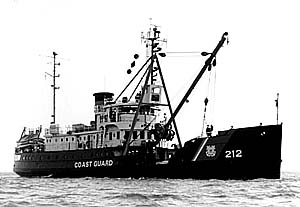
The United States Coast Guard Cutter Fir was the last lighthouse tender built specifically for the United States Lighthouse Service to resupply lighthouses and lightships, and to service buoys. Fir was built by the Moore Drydock Company in Oakland, California in 1939. On 22 March 1939, the U.S. Lighthouse Tender Fir was launched. She was steam driven with twin screws, 175 feet (53 m) in length, had a beam of 32 feet (9.8 m), drew 11 feet 3 inches (3.43 m) of water, and displaced 885 tons. Fir was fitted with a reinforced bow and stern, and an ice-belt at her water-line for icebreaking. She was built with classic lines and her spaces were lavishly appointed with mahogany, teak, and brass. The crew did intricate ropework throughout the ship. The cost to build Fir was approximately US$390,000. Fir's homeport was Seattle, Washington for all but one of her fifty one years of service when she was temporarily assigned to Long Beach, California when USCGC Walnut was decommissioned on 1 July 1982.

USCGC Pontchartrain (WHEC-70) was an Owasco class high endurance cutter built for World War II service with the United States Coast Guard. The ship was commissioned just days before the end of the war and thus did not see combat action until the Korean war.

The third USS Calypso (AG-35) was launched 6 January 1932 for the United States Coast Guard as USCGC Calypso (WPC-104) by the Bath Iron Works in Bath, Maine. She was initially stationed at San Diego, California and transferred to Baltimore, Maryland in 1938. She was transferred from the Coast Guard to the U.S. Navy on 17 May 1941 and commissioned the same day.
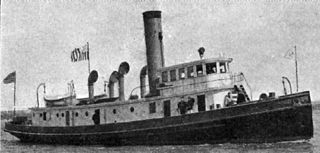
USRC Mackinac, later USCGC Mackinac, was a patrol boat that served in the United States Revenue Cutter Service from 1903 to 1915 and in the United States Coast Guard from 1915 to 1917 and from 1919 to 1939.

The Ukrainian patrol vessel Sloviansk (P190) was an Island-class patrol boat of the Naval Forces of the Armed Forces of Ukraine. Originally named USCGC Cushing when in service with the United States Coast Guard, the vessel was acquired by Ukraine in 2018 and arrived in Ukraine on 21 October 2019. Sloviansk was sunk in combat on 3 March 2022 by a Russian air-to-surface missile.

USCGC Woodrush (WLB-407) was a buoy tender that performed general aids-to-navigation (ATON), search and rescue (SAR), and icebreaking duties for the United States Coast Guard (USCG) from 1944 to 2001 from home ports of Duluth, Minnesota and Sitka, Alaska. She responded from Duluth at full speed through a gale and high seas to the scene of the SS Edmund Fitzgerald sinking in 1975. In 1980, she took part in a rescue rated in the top 10 USCG rescues when she helped to save the passengers and crew of the cruise ship Prinsendam after it caught fire in position 57°38"N 140° 25"W then while being towed sank off Graham Island, British Columbia. She was one of the first vessels to respond to the Exxon Valdez oil spill in 1989. She was decommissioned on 2 March 2001 and sold to the Republic of Ghana to serve in the Ghana Navy.
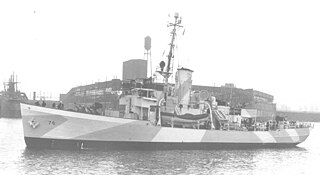
USCGC Comanche (WPG-76) was a United States Coast Guard cutter built by Pusey & Jones Corporation, Wilmington, Delaware, and launched 6 September 1934. She was commissioned on 1 December 1934. She was used extensively during World War II for convoy operations to Greenland and as a part of the Greenland Patrol.
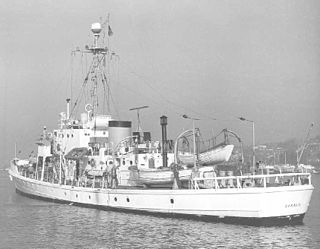
USCGC Cahoone (WPC/WSC/WMEC-131) was an Active-class patrol boat of the United States Coast Guard. Launched in 1927, she served until 1968.
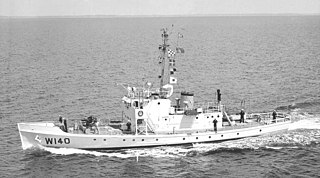
The Active-class patrol boat was one of the most useful and long-lasting classes of United States Coast Guard cutters. Of the 35 built in the 1920s, 16 were still in service during the 1960s. The last to be decommissioned from active service was the Morris in 1970; the last in actual service was the Cuyahoga, which sank after an accidental collision in 1978.

USCGC Argo (WPC-100) was a Thetis-class patrol boat belonging to the United States Coast Guard launched on 12 November 1932 and commissioned on 6 January 1933.
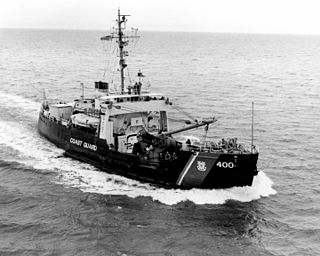
USCGC Salvia (WLB-400) was a United States Coast Guard Iris-class buoy tender in commission from 1944 to 1991. She operated in the Great Lakes and along the United States Gulf Coast during her career. Sold and renamed Brian Davis in 2020 for use as a memorial vessel, she was scuttled as an artificial reef in 2020.

USCGC Legare (WSC-144) was cutter that served in the United States Coast Guard for almost forty-one years.

USCGC Ironwood (WAGL-297/WLB-297) was a Mesquite-class sea-going buoy tender operated by the United States Coast Guard. She served in World War II, the Korean War, and the Vietnam War as well as a variety of domestic missions. She currently serves as a seamanship training vessel for Job Corps.



















